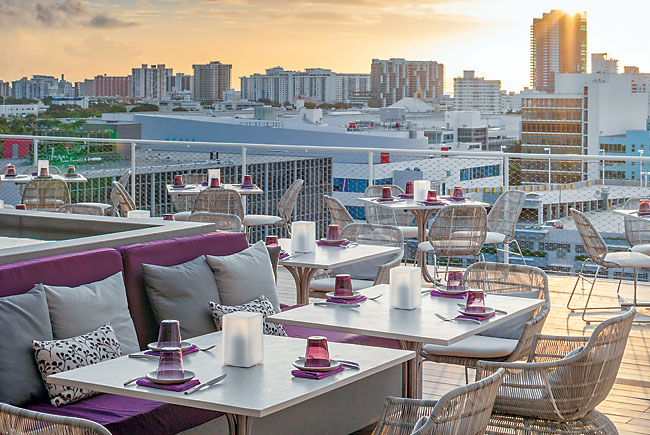The Future of Florida Dining

A table at Juvia, the packed new penthouse restaurant on South Beach, is a perfect spot to see the future of Florida restaurants.
Whether you are in the terrace looking out across 10 blocks of hotels to the Atlantic or in the vast glass dining room with a wraparound view north and back to Biscayne Bay, you are a cut above — actually, nine stories above the maddening crowds on Lincoln Road Mall.
You can taste the future as well in a menu that fuses Peruvian, Japanese and classic French: Cold-smoked scallops with bonito flakes, a crusty Peruano potato in a neon yellow amarillo pepper cream or duck breast with frites. This may be the only place where a beautiful bento box of Korean BBQ includes a cupcake topped with a swirl of lavender icing.
Below and two blocks away is last year’s “it’’ restaurant, Yardbird, still drawing lines for putting the sweet-tea south into South Beach. Top chefs serve divine fried chicken, butter bean risotto with artisan bourbon and more in a big stylish space fashioned from old brick, reclaimed barnwood and industrial seating with large jars of pickles as the chief artwork.
Look seaward out 17th to Collins Avenue and you can see the newest cluster of revamped hotels glittering with star chefs and architects. At the SLS, Washington hero José Andrés delivers glorious small plates next to a sushi bar designed by Philippe Starck. The new Kimpton Surfcomber draws its entire menu from a Hong Kong blend of Asian street food and Brit pub grub.
The center of Florida cuisine lies somewhere in this triangle between Japan, Peru and the Deep South. It is a mash-up of handsome presentation, exotic flavor and hand-made comfort cooking, a cuisine shaped with earnestness and celebrity glitz.
In Miami, the restaurants have more flash and higher prices, but the same elements are found across the state. Japanese style, Thai and Korean fire, South American arepas and ceviche are seen and tasted widely.
The view isn’t entirely sunny — especially for full-service, high-end independents. But Florida restaurants keep growing and innovating. For all the flash of top-dollar showplaces like Juvia and new caviar showplaces, the great energy is at lower price points.
Smart restaurateurs like Irv Miller at Jackson’s Steakhouse in Pensacola hope to end the year in the black. Miller is predicting a 15% rise in sales.
Statewide, the industry predicts more than $31 billion in receipts, up 4% from the prior year. To keep the patrons coming, Carol Dover, president and CEO of the Florida Restaurant and Lodging Association, is working with Emeril Lagasse on a TV series about Florida food to start on the Cooking Channel in January.
The big chains based here, like Darden and Outback, are also overhauling menus, formats and marketing to create more value at prices under $15.
No matter how green, local or organic they claim to be, clever chefs and entrepreneurs are thinking small. They prefer small-plate formats of tapas, sushi and mezze; they seek lower rents in modest neighborhoods. Instead of full-dress service, they try bakeries, burger counters and barbecue places. They love “street food’’ snacks and bites in sit-down restaurants as much as from a food truck.
Drink is as important as food and possibly more profitable, with craft beers, endless wine bars and expensive boutique cocktails.
And there’s a new welcoming attitude at the door of even the most chic. The role of host has been the last station in the restaurant to be professionalized and modernized. The job is no longer to turn away those with no reservations or good fashion sense.
Snippy hauteur has been replaced with a smile and an assurance: “I am sorry. We’re so crowded tonight. Let me see what I can do for you.’’
